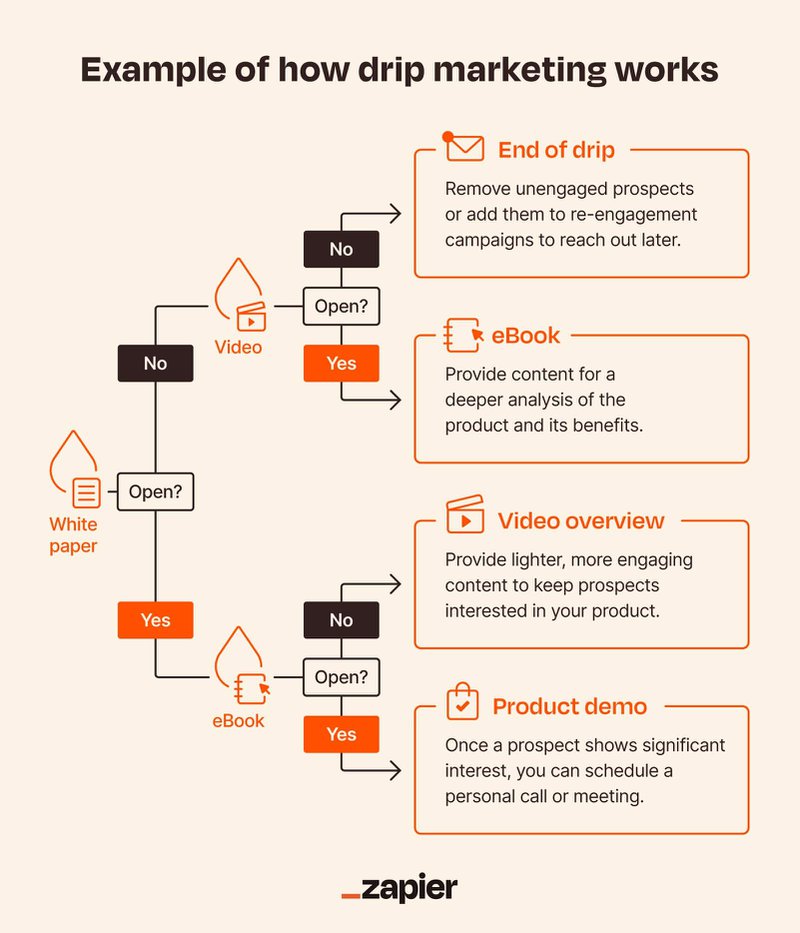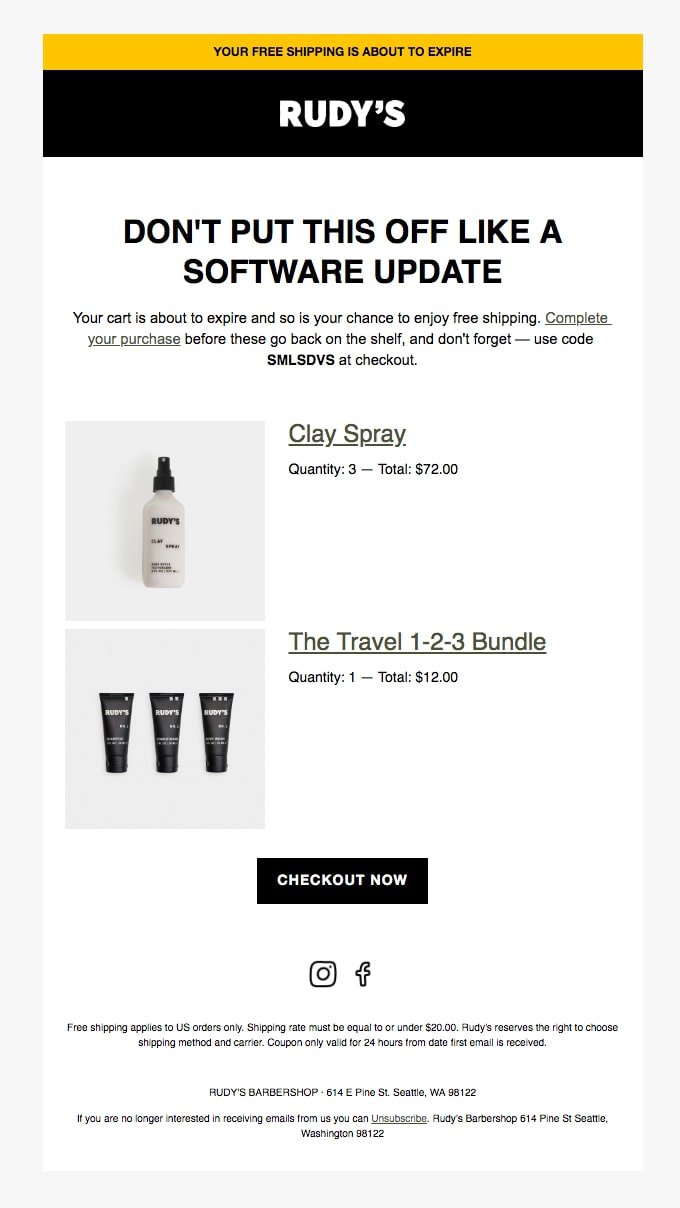Set Up Mailchimp Drip Campaigns in 7 Easy Steps + Examples
Drip campaigns are an effective way to engage, educate, and communicate with your audience. Mailchimp's drip campaign functionalities make all of that a breeze.
Updated December 7, 2023.

Drip campaigns are to email marketing what wafers are to gelato: they're more than just support; they're part of the deal.
Running a Mailchimp drip campaign is easier than ever. With built-in automation templates, design templates, and a smart Customer Journey builder, Mailchimp has provided busy business owners and email marketers with access to a conversion machine on autopilot.
How to use Mailchimp to build drip campaigns that nurture your leads and convert them more efficiently than ever before?
Read on and find out.
What is a drip campaign?
A drip campaign is a series of automated, pre-scheduled emails that are sent to targeted segments of your audience based on specific triggers or actions.
Unlike traditional one-time email blasts, drip campaigns are strategically designed to deliver relevant content at the right time, nurturing leads and guiding potential customers through their buying journey.
The term "drip" is actually borrowed from agriculture, where "drip irrigation" slowly delivers water to plants over a period of time. In the world of email marketing, drip campaigns are used to slowly "drip" relevant content and messages into your subscribers' inboxes.
Advantages of a drip campaign
There are many reasons drip campaigns are so popular:
Improved conversions
Research shows that businesses that run email drip campaigns generate 80% more sales at roughly one-third of the cost they'd pay for other types of marketing.
Targeted, relevant, and compelling drip emails bring your audience closer to your brand – and thus more likely to buy from you repeatedly.
Saving time
Once you've set up your drip campaign, it runs automatically, freeing up your time and resources for other essential tasks.
Lead nurturing
Drip campaigns are excellent for nurturing leads and building trust over time by providing valuable information and insights.
Higher engagement rates
Personalized and timely emails are more likely to capture your audience's attention, leading to higher open and click-through rates, especially when they are combined with Mailchimp SMS campaigns. Studies show approximately 72% of people prefer to receive promotional materials via email (compared to less than 20% who prefer seeing them on social media).
Personalization
Think of it this way: when you visit your neighborhood stores, don't you feel better when the staff knows your name?
The same happens in email marketing, as well. Mailchimp drip campaigns enable you to segment and personalize the messages in your email flow so that you make your target audience feel appreciated and valued with each interaction they have with your brand.
Staying top of mind
"Out of sight, out of mind" may not always be true v but when it comes to online marketing, it might just get too close to reality.
Fact: there are a lot of businesses, websites, and social accounts out there. Unless you've already created a very steady base of loyal customers, chances are that people who've only interacted with your brand once or twice will easily forget about you.
Mailchimp drip campaigns are a great way to stay top of mind and remind your audience why they should keep coming back to your website – or even better, buy from you again.
Pro tip: Make sure that you are GDPR-compliant in all of your communication. Luckily, Mailchimp has built-in GDPR features.
Re-engage potential customers
Drip email campaigns are perfect for eCommerce businesses that want to re-engage customers who have shown interest in the past but haven't made a purchase or have abandoned their shopping carts.
For instance, if someone's visited your site but hasn't made any purchase, sending them a browser abandonment email can bring them back to your website. It can also make them more ready to buy, especially if you incentivize them.
How Mailchimp drip campaigns work
Mailchimp's email marketing tool allows you to create various drip email campaigns with ease.
Essentially, any email series you create can either be pulled from one of the Mailchimp pre-set automations available or created from scratch. In both cases, building an email automation is an intuitive, smooth process.
There are two types of email automation triggers you can choose from:
Date-based automations
Date-based emails are triggered at a specific time, which may be a date in the calendar or a certain amount of time from a trigger moment. Generally, this type of communication tends to be either transactional emails (e.g. confirming subscription) or single email campaigns (e.g. emails celebrating a special event.)
Subscriptions and reorders
Subscriptions and reorders are usually communicated through time-triggered emails when users pay for a subscription. For instance, a streaming service could trigger the same reminder every month, on the same day, so that their users don't forget to make sure there's enough money on their card to pay the subscription.
Likewise, if you can calculate how long it takes for a consumer to finish a product they need recurrently (like laundry detergent or organic dog food), you can trigger an email campaign to send out when the customer is almost done with the product. This way, you will remind them they need a refill, making it a win-win situation for everyone.
Birthdays, anniversaries, and special events
Celebrate your customers' special moments with personalized emails, exclusive discounts, or thoughtful messages to build a strong emotional connection. Some of the types of campaigns you could include here are
- Company anniversary emails
- Happy birthday emails
- Mother's Day emails
- Black Friday emails
- April's Fools emails
- St. Patrick’s Day emails
This type of email marketing campaign will loyalize your existing customers, make you more attractive to your potential leads, and strengthen your branding efforts.
Pro tip: don't know when your customers' birthdays are? And don't want to add it to your checkout page? Just send out a Mailchimp survey.
Behavior-based communications
Unlike time-triggered emails, behavior-driven communications are all about specific user actions, such as signing up for a newsletter, buying something, or wandering around your website on particular pages.
Here are some of the most successful types of behavior-driven drip email campaigns you could build:
Welcome series
After a buyer signs up for your emails, initiate a welcome series to introduce your brand, showcase your best content, and set the tone for future communication. This drip sequence doesn't have to be very long. Usually one to three emails are enough to keep the customers engaged and close to your brand, but this does vary by industry.
First purchase
Once a customer makes their first purchase, send a thank-you email, request feedback, and suggest related products to encourage repeat purchases. Sometimes, the first purchase email is the same as the welcome series, depending on the nature of the product you're selling and how you want to structure your drip campaign email.
Product recommendations
Utilize data from past purchases or browsing behavior to send personalized product recommendations, increasing the chances of cross-selling and upselling. These emails can help you sell more, loyalize your customers, and introduce them to new product lines or categories.
Say you run a software as a service business and your pricing plan is split between a standard plan and a couple of premium plans. In this case, you can send drip campaigns to people in the lower-priced, essential plans, to convince them to upgrade to a plan that allows them to add more enterprise users to their account.
Follow-up educational/onboarding emails
For customers who have purchased a complex product or service, a follow-up email series can provide educational content to help them maximize its benefits. Make sure the type of content you send out is relevant to your customers and the specific product they have purchased.
This type of email campaign can be adapted for inactive users too. For instance, if someone signed up for your software but hasn't used it yet, you can create a follow-up educational sequence to engage these people and nudge them to use your product.
Abandoned cart and browser abandonment
Cart abandonment emails remind potential shoppers about the products they've left in their shopping carts. Browser abandonment emails are very similar, but their purpose is to remind people of products or product categories they've looked at on your website.
Both types of emails are based on the user behavior identified on your site. However, before you send abandonment emails, remember to collect potential customers' email addresses. Note: you will likely have to incentivize people to share their addresses via opt-in forms if they haven't bought anything from you yet.
Lead nurturing
According to recent studies, more than 60% of people who show interest in your business aren't ready to buy – but they end up converting after a lead nurturing campaign.
Lead nurturing drip sequences aim to nurture email subscribers who are not customers yet, but have shown interest in the product or service you sell. These emails will guide leads through the sales funnel with carefully crafted content that addresses their pain points and showcases the value of your content.
As a general rule, the emails at the beginning of this type of workflow should be based on informative content that shows you understand your customer's pain points and reasoning. The more you move down the funnel, the emails should include more sales-oriented copywriting that aims to nudge leads to convert.
Pro tip: Want to make sure your email copy is taking leads straight to the checkout? Hire a professional email copywriter vetted by Mayple!
Drip email best practices to remember
Knowing what type of Mailchimp drip campaign to send is the first step to building automation workflows that help you sell (and retain) more customers. Aside from that, here are more tips to keep in mind:
Make sure your messages are targeted
The more you segment your email list, the more targeted and en pointe your communications will be. For example, you can segment your audience based on their preferences, behavior, and demographics to deliver relevant content.
You can also segment your existing customers based on the type of product they bought from you. For example, you will likely send different emails to a premium plan customer vs. a free or standard subscriber.
Keep your email copy crystal clear
Use concise and engaging language that clearly conveys your message and call to action. While it may be tempting to get clever with your copy, the goal is to have your reader understand what you want them to do as soon as they read it.
Keep the buyer journey in mind
Tailor your drip campaign to align with the various stages of the buyer's journey, providing the right information at the right time. For example, someone who is just in the awareness phase will likely need different messages and information than someone who is already in the decision stage.
Don’t send too many emails
While drip campaigns are automated, which makes it extremely easy to schedule and send as many emails as you need. No one likes being spammed, though, and too many emails from you will do just that. Be cautious not to overload your audience, as they will likely unsubscribe.
Keep testing and tweaking
Be sure to monitor the success of your campaigns regularly and adjust accordingly. Multivariate testing lets you compare two versions of the same email, so you can see which one performs better. This will help you optimize your emails in the long run.
Include a CTA
Every email in your drip campaign should have a clear call to action, guiding recipients toward the next step you want them to take. This might seem obvious to you, but neglecting to include a clear CTA is more common than you think, leading to confused readers and lower click-through rates.
Personalize your campaign
Use merge tags and dynamic content to personalize your emails, making your subscribers feel valued and acknowledged. Remember to make this sound honest, rather than intrusive or over-the-top. Too many merge tags might come off as disingenuous.
Make sure all of your data is synced between your email campaigns, your SMS tool, and your website (whether it’s built using Shopify, Wix, or Mailchimp website builder).
How to set up your Mailchimp drip campaign
Setting up your Mailchimp drip campaign is a straightforward process:
Go to Mailchimp Automations
Log in to your Mailchimp dashboard, click on "Automations" in the top menu, and select "Classic Automation" to begin creating a new automation.
Pick the type of automated emails you need
Pick the automation type that aligns with your campaign's goal, such as "Welcome New Subscribers" or "Abandoned Cart." If you want to build your own automation, you can also choose to create a "custom campaign."
Once you pick the type of automated email, you will also have to choose whether you want to send a "single email" or an "email series."
Enter your campaign name
If you run multiple Mailchimp drip campaigns, make sure you create a naming convention everyone on the team knows about. This way, you won't mistake emails or campaigns that you're running.
Adjust your customer journey
Define the start trigger, which is the action that will initiate your drip campaign. Set the time delay between emails to create a well-paced and engaging customer journey.
Choose your email criteria
Customize the content, sender email, subject line, and preview text for each automated email in your sequence. If you have multiple emails in the series, you will have to adjust the settings and the email content for each email.
Publish your drip campaign
Once your emails are sent out, review and test your automated emails to ensure everything looks and works as intended before setting your campaign live.
How to use Mailchimp Customer Journeys
Mailchimp's Customer Journeys allow you to take your marketing to the next level. They function similarly to Classic Automations, but have more advanced options and automated marketing paths. For instance, when you use a Customer Journey automation, you can choose multiple starting points and branches, to fit your customer's behaviors.
Here's how to build a Mailchimp drip campaign using Customer Journeys:
1. Access Customer Journeys
- Click the Automations icon and select Overview.
- Hit the Create Journey button.
2. Name your journey and choose your audience
Enter a Name for your journey, choose your audience and then click on the Start Building button.
3. Add starting points
- Click on Choose A Starting Point
- Choose a starting point, such as "Signs Up" or other actions that add contacts to the journey.
- Customize settings for each starting point.
- Optionally, use segmenting conditions to filter your starting point.
- Click Save Starting Point.
5. Add journey points
- After adding starting points, choose the rules and actions (i.e. journey points) that make up your journey. To do this, start by clicking on the + sign.
- Then, click on Add a journey point.
- Use a combination of rules and actions to create a unique customer workflow.
6. Activate your journey
- When you've finished your Customer Journey, click Continue.
- Choose a marketing objective to help Mailchimp provide personalized recommendations and reporting.
- Click Turn On to activate your customer journey.
7. View stats and queue
- On the Customer Journey homepage, you can see the number of contacts at different stages of the journey. Some of the key stats will also appear on Tag and Email actions when contacts reach those specific journey points.
- If you want to view stats for a journey, you've paused, click on View Data.
- To look at all the data for an email, click the Report icon.
- See the list of contacts at a specific step by clicking on the three vertical dots on the top right side of the box; click on View Contact Queue.
That's it! You've successfully created and activated your Mailchimp Customer Journey. Now, your audience will receive personalized and automated emails based on their interactions, helping you nurture leads and drive conversions.
Measure your success
To gauge the effectiveness of your Mailchimp drip campaign, keep an eye on these key metrics:
- Audience growth: Monitor how your subscriber list grows during the course of your drip campaign.
- Click-through rates: Track how many recipients clicked on links within your emails, indicating engagement and interest.
- Open rates: Measure the percentage of recipients who opened your emails, showing how compelling your subject lines and content are.
- Revenue: If your drip campaign is geared toward sales, keep an eye on the revenue generated from the campaign, directly attributing it to your email efforts.
Mailchimp drip campaigns: a goldmine for your team
Drip campaigns are a great solution for pretty much every member of the marketing team, not just for email marketing experts. It offers:
- A growth channel for social media, by including social buttons in emails
- A distribution channel for content marketers who can include educational and editorial content in the emails
- A source of data for PPC advertisers as they can collaborate and learn more about what your audience likes
Mailchimp drip campaigns are easy to build, cover your marketing bases, and deliver the message you need your audience to hear. While many might argue that there are email software options more advanced than this, Mailchimp does a great job at making this feature user-friendly.
Want to make the most out of Mailchimp? Contact us and allow us to match you with the best Mailchimp expert for your niche in a matter of days, so you can start working together ASAP!
































